The German-American architect Ludwig Mies Van Der Rohe was one of the most influential representatives of the International Style. He believed that “less is more,” and he designed rational and minimalist skyscrapers, houses, and furniture.
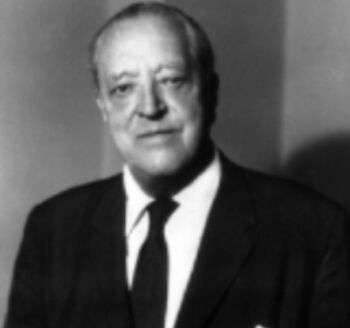
Image source: https://en.wikipedia.org/wiki/Ludwig_Mies_van_der_Rohe#/media/File:Ludwig_Mies_van_der_Rohe.jpg
About His Life
Born in Germany in 1886, Ludwig Mies van der Rohe broke new ground with his architectural designs, starting as a draftsman before striking out later on his own. During World War I, Mies served in the German military and became a well-known architect in Germany. He created famous structures, such as the German Pavilion for the 1929 Barcelona Exposition. Additionally, he acted as the third and last Bauhaus director. In the late 1930s, Mies immigrated to the United States, where he created such well-known Modernist works as the Lake Shore Drive Apartments and the Seagram Building. He died in 1969.
His Multifaceted Body of Work
Before Mies immigrated to the United States, he had already realized several remarkable architecture pieces.
- The Urbig House (1917) in Potsdam, Germany
- The Afrikanische Strasse (1925) in Berlin, Germany, which filled Berlin’s growing need for middle-class housing.
- The Weissenhofsiedlung (1927) in Stuttgart, Germany, was composed of 20 buildings (now with 11 surviving).
- The Barcelona Pavillion, demolished in 1930 at the 1929 World’s Fair, was designed by Mies and other 17 architects. Later, rebuilt on the same site.
- The Lange and Esters Houses (1930) in Krefeld, Germany
- The Bauhaus Berlin (1930) in Berlin, Germany and was formerly a derelict factory that the students renovated under Mies’ direction.
- The Villa Tugendhat (1930) in Brno-Brno-sever, Czech Republic
- The Lemke House (1933) in Berlin, Germany, is the last house by mies in Germany.
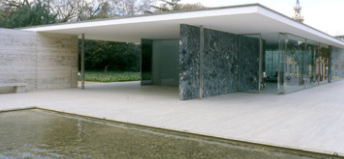
Image source: https://search.creativecommons.org/photos/5f893424-32cd-4f1c-830c-ddc7f19423d3 by Sandro Maggi Architetto
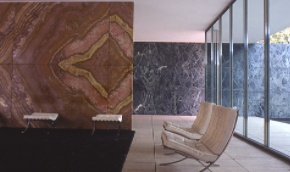
Image source: https://search.creativecommons.org/photos/30f9ca49-e83e-47a5-8740-401b6627a428 by Sandro Maggi Architetto
His Work in the United States
After he arrived in the United States, Mies wasted no time getting to work. He designed the Illinois Institute of Technology, then known as the Armour Institute, the Promontory Apartments, and the Farnsworth House, which is one of the best examples of American modernism. Additionally, he designed the Lake shore Apartments, composed of a pair of steel-fronted towers, the Crown Hall, home of the College of Architecture at the Illinois Institute of Technology, the Seagram Building, and Lafayette Park, which is on the site of a slum and intended to prevent the middle-class from fleeing to the suburbs.

Image source: https://search.creativecommons.org/photos/2c2195d3-bf14-4bb3-8c6d-908853a5187f by Tim Brown Architecture

Image source: https://search.creativecommons.org/photos/a8163ae9-919b-497e-a511-bcac24299cd4 by en:User:Mikerussell
In his late years, he designed the New National Gallery, in Berlin, Germany, which opened in 1968 and cantilevers a primary exhibit hall over a glassy central pavilion. The characteristic open interior space defies the traditional, heavily-partitioned museum experience.
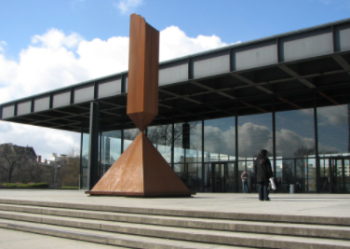
Image source: https://search.creativecommons.org/photos/c563b6f1-07cf-4476-9130-62a9276dce4d by Lauren Manning
Mies, often collaborating with Lilly Reich, designed modern furniture pieces using the then-new industrial technologies. They created pieces that have become popular classics, such as the Barcelona chair, the Brno chair, and the Tugendhat chair. His furniture, known for its fine craftsmanship, has a mix of traditional luxurious fabrics like leather combined with modern chrome frames. Additionally, it often has a distinct separation of the supporting structure and the supported surfaces, employing cantilevers to enhance the feeling of lightness created by the delicate structural frames.
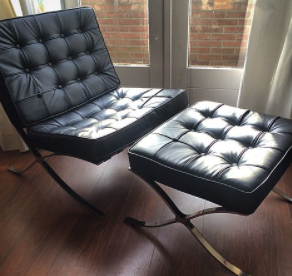
Image source: https://search.creativecommons.org/photos/c7fee43d-fd87-405d-ac15-af9fbb4029cc by GuySie
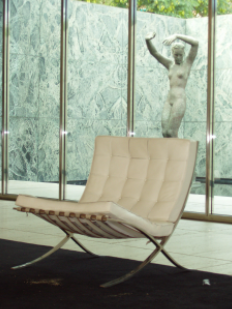
Image source: https://commons.wikimedia.org/wiki/File:Pavell%C3%B3_Mies_06.JPG
Identifying Mies’ Style
Mies van der Rohe and his designs were deemed nothing less than visionary, placing him at the forefront of modern architecture. Also, not only did he set the standard for all modernist design, but brought European modernism to America. He is often associated with the aphorisms, less is more
The Details
Mies’s attitude towards architecture and design was shaped by some avant-garde art schools, which blossomed in the 1920s, including the Bauhaus, embodied by the works of Walter Gropius, the Dutch De Stijl group, the Russian Constructivism, the design concepts of the Czech-born architect Adolf Loos (1870-1933), and the American Prairie Style building designs of Frank Lloyd Wright (1867-1959).
Further, he pioneered the extensive use of glass in buildings. In addition, his works introduced a new level of simplicity and transparency, and his buildings were often referred to as “skin-and-bones” architecture for their emphasis on steel structure and glass enclosure.
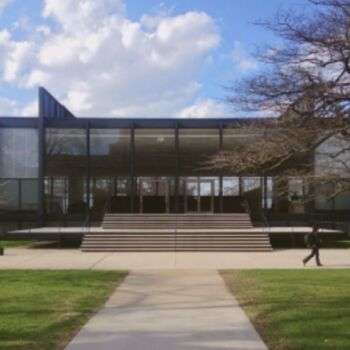
Image source: https://search.creativecommons.org/photos/b5c4e1b6-b6e2-4547-8734-600ecda4a2dd by Peter Alfred Hess
Info sources:
https://www.biography.com/people/ludwig-mies-van-der-rohe-9407940
https://www.thoughtco.com/mies-van-der-rohe-neo-miesian-177427
http://www.archdaily.com/574575/material-masters-glass-is-more-with-mies-van-der-rohe
http://www.visual-arts-cork.com/architecture/mies-van-der-rohe.htm
https://www.curbed.com/maps/mies-van-der-rohe-important-works
http://www.ranker.com/list/ludwig-mies-van-der-rohe-buildings-and-structures/reference

Comments are closed.